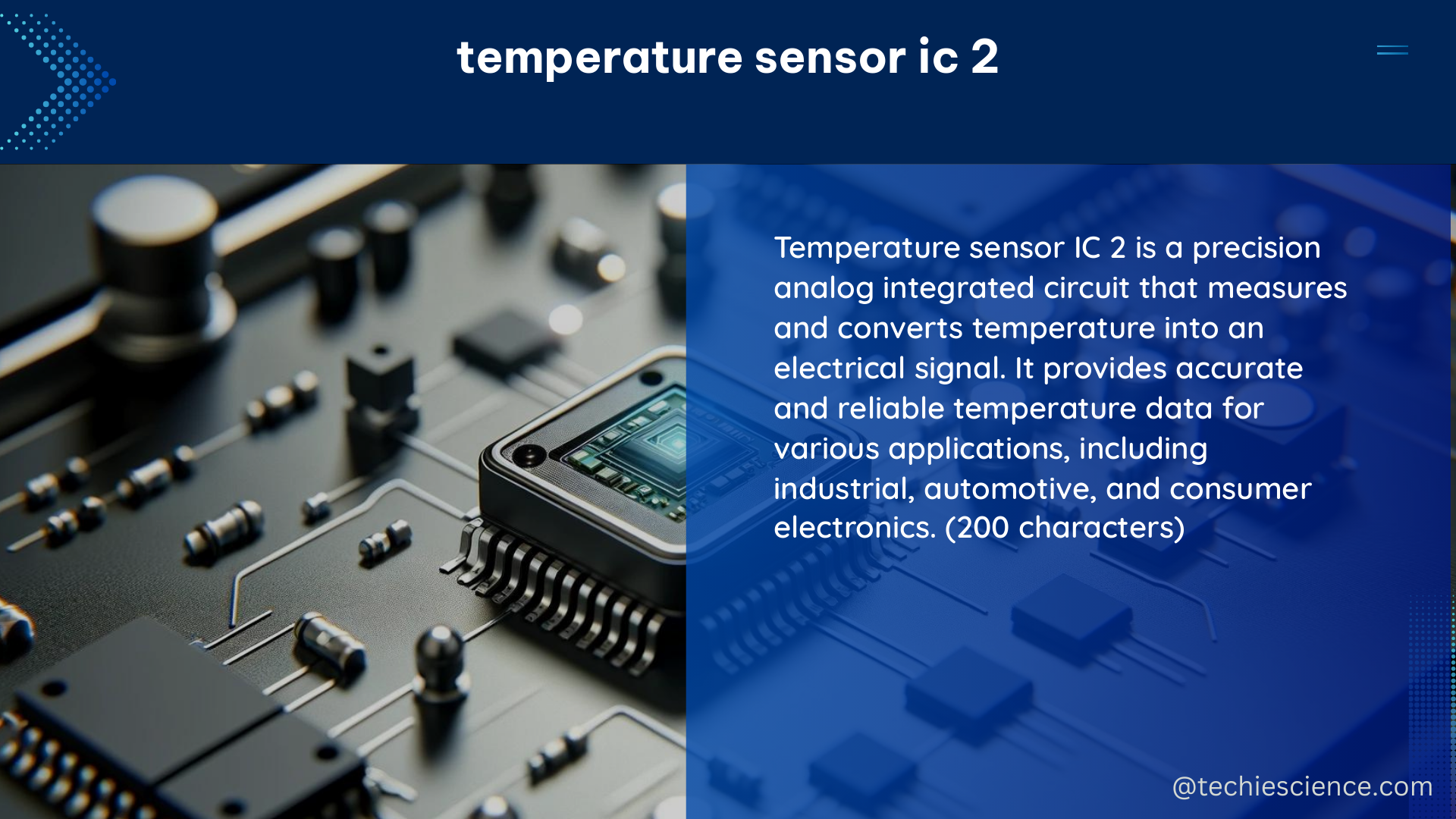The temperature sensor IC 2, also known as the in-cylinder air temperature (IAT) sensor, is a critical component in automotive engines that measures the temperature of the air-fuel mixture before it enters the engine cylinders. This sensor plays a vital role in determining the optimal fuel-air mixture, ignition timing, and overall engine performance. In this comprehensive guide, we will delve into the technical specifications and DIY aspects of the temperature sensor IC 2, providing you with a detailed understanding of this essential automotive component.
Technical Specifications of Temperature Sensor IC 2
Sensing Element
The sensing element in a temperature sensor IC 2 is typically a thermistor, a temperature-sensitive resistor that changes resistance with temperature. The thermistor is usually located in the IAT sensor’s tip, which is exposed to the air-fuel mixture. The thermistor’s resistance varies inversely with temperature, allowing the sensor to accurately measure the air temperature.
Temperature Range
The temperature sensor IC 2 can typically measure temperatures between -40°C (-40°F) and 125°C (257°F). However, some sensors may have an extended temperature range, depending on the specific application and engine design. For example, high-performance engines or those used in extreme environments may require sensors capable of withstanding temperatures up to 150°C (302°F) or even higher.
Accuracy
The accuracy of a temperature sensor IC 2 is typically specified as ±2°C (±3.6°F) to ±5°C (±9°F) over the operating temperature range. This level of accuracy is essential for the engine control unit (ECU) to make precise adjustments to the fuel-air mixture and ignition timing, ensuring optimal engine performance and efficiency.
Response Time
The response time of a temperature sensor IC 2 is the time it takes for the sensor to reach 63.2% of the final temperature when subjected to a step change in temperature. This parameter is crucial for the sensor’s ability to quickly detect and respond to changes in the air-fuel mixture temperature. Typical response times for temperature sensor IC 2 range from 0.1 seconds to 1.0 seconds, depending on the sensor’s design and construction.
Output Signal
The output signal of a temperature sensor IC 2 is typically an analog voltage or current that varies with temperature. The output signal is usually converted to a digital signal by the engine control unit (ECU) for further processing and control. The voltage or current output range can vary, but it is often between 0 to 5 volts or 4 to 20 milliamps, respectively.
Power Consumption
The power consumption of a temperature sensor IC 2 is typically low, ranging from a few milliwatts to a few hundred milliwatts, depending on the sensor’s design and construction. This low power consumption helps to minimize the overall energy requirements of the engine’s electronic systems, improving fuel efficiency and reducing the strain on the vehicle’s electrical system.
DIY Aspects of Temperature Sensor IC 2

Installation
Installing a temperature sensor IC 2 requires access to the engine compartment and knowledge of the engine’s layout and components. The sensor is typically installed in the intake manifold or air cleaner housing, where it can measure the temperature of the air-fuel mixture before it enters the engine cylinders. Proper installation is crucial to ensure accurate temperature readings and optimal engine performance.
Calibration
Calibrating a temperature sensor IC 2 involves adjusting the sensor’s output signal to match a known temperature standard. This process is typically performed using specialized equipment and software, such as a digital multimeter and engine diagnostic tools. Some temperature sensor IC 2 models may be self-calibrating or require minimal calibration, simplifying the maintenance process.
Troubleshooting
Troubleshooting a temperature sensor IC 2 involves checking the sensor’s wiring, connections, and output signal for signs of damage or malfunction. Common issues include open or short circuits, corrosion, and mechanical damage. In some cases, the sensor may need to be replaced if it is not functioning within the specified accuracy and response time parameters.
By understanding the technical specifications and DIY aspects of the temperature sensor IC 2, you can ensure proper installation, calibration, and maintenance of this critical automotive component. This knowledge will help you optimize engine performance, improve fuel efficiency, and maintain the overall health of your vehicle’s engine system.
References
- RFA-TR-21-009: Screening for Conditions by Electronic Nose
- Joint Targeting School Student Guide
- dafi10-2501.pdf – Air Force – AF.mil
- What Is The In Cylinder IAT Drop With e85
- Novel Passive RFID Temperature Sensors Using Liquid Crystal

The lambdageeks.com Core SME Team is a group of experienced subject matter experts from diverse scientific and technical fields including Physics, Chemistry, Technology,Electronics & Electrical Engineering, Automotive, Mechanical Engineering. Our team collaborates to create high-quality, well-researched articles on a wide range of science and technology topics for the lambdageeks.com website.
All Our Senior SME are having more than 7 Years of experience in the respective fields . They are either Working Industry Professionals or assocaited With different Universities. Refer Our Authors Page to get to know About our Core SMEs.